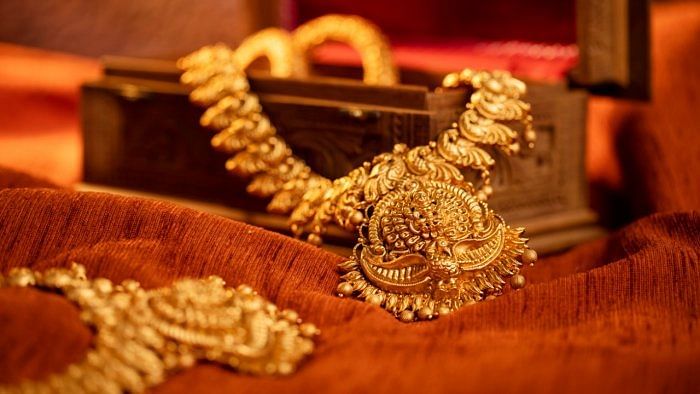
By Adrija Chatterjee, Swansy Afonso and Shruti Srivastava
India’s wide trade deficit is highlighting a curious government plan to rein in the gap: Getting people to hand over their private stashes of gold jewellery.
Prime Minister Narendra Modi and his government have been trying to convince gold-obsessed citizens - who collectively own the biggest private holding of bullion in the world - to deposit their treasures with banks and earn interest.
The plan, which dates back seven years, has been a resounding flop, luring only about 25 tonnes of the 25,000 the World Gold Council estimates is held by households and temples in the south Asian nation.
But now, the impetus behind it - to stem India’s massive gold imports and reduce the trade deficit by melting down the metal already in the country and reselling it - is newly relevant as the rupee slumps and the trade gap hovers near the record high it hit in July.
“If you can recycle the existing gold back home, then reliance on gold imports comes down and it will reduce pressure on the current account deficit,” said Madhavi Arora, lead economist with Emkay Global Financial Services Ltd. “And you can also monetise the gold as an instrument to raise funds.”
Sakshi Gupta, principal economist at HDFC Bank Ltd., said when it comes to efforts to reduce India's import bill — whether be it on gold or oil — “every percentage point at this juncture counts.”
The government tried to discourage the purchase of bullion in July by raising the import tax on gold to an all-time high. But a drop in global prices offset the impact. This has been apparent during the current Indian festival season — a time when demand for gold peaks, especially during Diwali.
Modi’s program, which was originally set up in 2015, allows people to deposit their gold in a bank for a period of one to 15 years in return for interest payments of up to 2.5 per cent on the value of the metal and a promise to return the equivalent amount of gold, or cash, at the end of the term. The metal is then melted down and resold, in theory boosting local supplies and trimming imports.
In comparison with the interest rate on the gold program, the State Bank of India offers a rate of 5 per cent to 6 per cent on fixed cash deposits for a similar time frame.
The challenge for Modi is that gold is an emotional purchase for Indians. Jewelry plays an important role in weddings and festivals, with bracelets, rings, necklaces and earrings often handed down through families. One of the big drawbacks of the program is that the jewelry is melted to check for purity before being resold, which means depositors can never get their beloved heirlooms back.
Temple treasures
That’s where temples come in. The revered institutions, which are managed by trusts empowered by law to act on behalf of a deity, fill a vital role in Indians’ relationship with gold. Devotees donate the metal to the deities to express gratitude — for example for the birth of a child — leaving the temples with a vast store of the treasure. The trusts are estimated to hold about 4,000 tons, a stockpile about as big as the US Bullion Depository at Fort Knox.
Temple trusts are critical for the plan and the government should work with them, according to Ashish Pethe, chairman of the All India Gem & Jewellery Domestic Council.
“There are at least 10 to 15 trusts holding big amounts of gold, so if some amount of the gold comes out from them, then it will be a big relief,” he said.
So far, temples are depositing about 200 to 500 kilograms (440 to 1100 pounds) of gold in small quantities. But that is nothing compared to what is required for the program to work, according to James Jose, managing director of key Indian gold refinery CGR Metalloys Pvt Ltd.
Surendra Mehta, national secretary of India Bullion and Jewellers Association Ltd., says the difficulty also arises in convincing all the trustees of temples to allow the gold deposited to be melted under the scheme and risk upsetting their devotees.
Generational value
Most Indians, like Aditi Das, are happy to pay a bank to safeguard their ornaments in lockers rather than earn interest by depositing it at the same bank under the government program. The newly-married 32-year-old research scholar said the plan didn’t appeal because of the “generational value” of her ornaments.
“Most of my gold is inherited jewelry and has sentimental value and the idea of it being melted is not comforting,” Das said. “Even if it is a gold coin or a gold bar, it is bought on special occasions, and therefore I would not be comfortable giving it up for such a scheme.”
Another stumbling block has been the operational aspects on the ground, said Pethe. There needs to be flexibility in how long the gold is deposited for and there should be “no questions asked” about proof of purchase up to a certain limit, as it is often difficult for people who have inherited gold to prove ownership, Pethe said.
The deposit plan and a related sovereign gold bond scheme, which allows an investor to buy a bond priced at the value of gold without an underlying physical asset, are a “far cry from success,” representing less than 2 per cent of India’s annual gold consumption, according to Emkay's Arora. Still, rather than scrapping the plan, the government should consider amendments by sparing deposits in banks up to a limit of about 100 grams from tax department scrutiny and other tax exemptions, she said.
“The idle gold stock needs to be a part of the mainstream capital raising mechanism,” she said. “It is the only efficient and productive way to optimise on the existing stock of gold.”